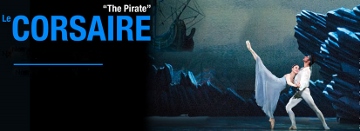BEAUTIFUL BOOTY
Nearly 200 years ago to the day that Lord Byron published his poem The Corsair, ABT’s monumental 3-act ballet on which it is based came bounding into the Dorothy Chandler Pavilion on Friday, offering sumptuous visuals, an enormous cast and orchestra, and crowd-pleasing virtuoso performances. Le Corsaire (“The Pirate”) 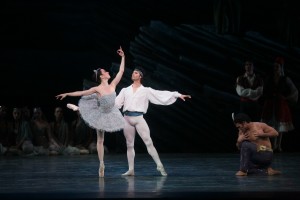 premiered in 1856, but Marius Petipa overhauled Mazilier’s swashbuckling romance for the Maryinski Ballet in 1899. Utilizing music of five composers, including Delibes and Drigo, Petipa’s version is the one on which all subsequent productions have been based. It’s curious that this cavalcade of dance from the man who brought us The Sleeping Beauty, The Nutcracker and Swan Lake (the latter of which premiered four years prior to Le Corsaire) didn’t land on U.S. shores until 1989. American Ballet Theatre added Corsaire to its repertory in 1998, retooled it in 2011, and again this year. The production playing through Sunday at the Chandler is the latest, which premiered 3 months ago in D. C.
premiered in 1856, but Marius Petipa overhauled Mazilier’s swashbuckling romance for the Maryinski Ballet in 1899. Utilizing music of five composers, including Delibes and Drigo, Petipa’s version is the one on which all subsequent productions have been based. It’s curious that this cavalcade of dance from the man who brought us The Sleeping Beauty, The Nutcracker and Swan Lake (the latter of which premiered four years prior to Le Corsaire) didn’t land on U.S. shores until 1989. American Ballet Theatre added Corsaire to its repertory in 1998, retooled it in 2011, and again this year. The production playing through Sunday at the Chandler is the latest, which premiered 3 months ago in D. C.
Given that this is a story ballet, please note that the storytelling is not the thing. A great many characters are introduced in a convoluted first act: The chief pirate Conrad arrives at a bazaar in Turkey with his slave Ali and friend Birbanto. Lankendem, the owner of the bazaar, has sold two slave girls to a pasha (or Turkish 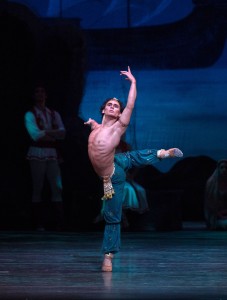 ruler). Conrad has fallen for one of them, the lovely Medora, and orders his crew to steal ALL of the slave girls, loot the village, kidnap Lankendem, and bring the collective booty to his grotto hideout (not a bad plunder for eight pirates).
ruler). Conrad has fallen for one of them, the lovely Medora, and orders his crew to steal ALL of the slave girls, loot the village, kidnap Lankendem, and bring the collective booty to his grotto hideout (not a bad plunder for eight pirates).
When Conrad decides to release the slave girls in Act II, Birbanto declares mutiny, but Conrad, like Errol Flynn, overtakes the crew. When Conrad sniffs a flower doused in a sleeping potion devised by Birbanto, Medora defends her lover by slashing Birbanto’s arm with a dagger. Lankendem steals Medora and whisks her back to the pasha’s palace where, in Act III, the pasha has a lengthy dream about the gorgeous women he possesses. Conrad shoots Birbanto and takes Medora back to his ship – which is caught in a storm and sinks, leaving Conrad and Medora on a rock. The silly libretto doesn’t even bother to tell us what happened to his faithful crew or his sensually subservient slave, Ali.
Here’s something else that’s odd. Having nothing to do with the libretto, Anna-Marie Holmes (who staged after Petipa and Konstantin Sergeyev, choreographer for the Boston Ballet in 1997) continues to offer the evening’s climax not in the third act, but in the top of the second. It is the famous pas de trois in which Medora, Conrad and his slave, Ali, dance to celebrate their plunder and entertain the crew shortly after returning to the grotto. Fortunately, the combination of unadulterated classical genius and flabbergasting virtuosity is exactly what is 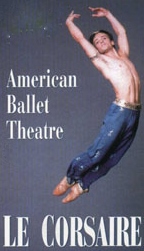 expected from American Ballet Theatre. What we get is a triumvirate of dancers in their prime, exhibiting their talent with seeming effortlessness and unruffled perfection.
expected from American Ballet Theatre. What we get is a triumvirate of dancers in their prime, exhibiting their talent with seeming effortlessness and unruffled perfection.
Of this trifecta, Argentine Herman Cornejo showed remarkable technique and animated power as Conrad, but his part is simply not as showy as the others, regardless of stage time. Cuban Xiomara Reyes hit her marks with seeming hesitancy at first as Medora, but became suppler with a far greater extension of line as the night progressed; while she did not display a breadth of exoticism – her naïf-like interpretation reminded me of Clara from The Nutcracker – her pirouettes and leaps were executed with precision. As was predicted, a bronzed and swarthy Ivan Vasiliev simply owned the night as the slave. True, this supplementary role is one of the classical repertoire’s choicest and most challenging male parts based on its inherent athleticism, but the astonishing Vasiliev’s tricky moves elicited gasps from the crowd, many of whom were from the dance world. He executed outrageously high jumps and overreaching legwork – which incorporated complicated changes of direction – with such stultifying composure that we know we are in the presence of a great artist. Now, if he could just stay in the air a little bit more, his name will soon be mentioned alongside Baryshnikov and Nureyev. Sadly, the remainder of the show is never as thrilling.
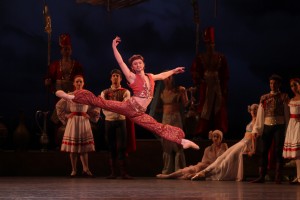 Aside from the 7-minute pas de trois, the best dancing came from Russian Daniil Simkin as the slave-selling Lankendem. While many dancers had a wobbly moment here and there (two ran into each other and another fell on her keester), Simkin (a Principal Dancer since last December) never faulted once. He partnered with Reyes even more gracefully than Cornejo, and presented seamless sky-high barrel turns. ABT’s Associate Artistic Director Victor Barbee spiced up the comic elements with hysterical Burlesque pratfalls and joyous Eddie Cantor-esque skipping and clapping. Sarah Lane (who danced for Natalie Portman in The Black Swan) also shined in the fairly thankless role of Gulnare, Medora’s friend.
Aside from the 7-minute pas de trois, the best dancing came from Russian Daniil Simkin as the slave-selling Lankendem. While many dancers had a wobbly moment here and there (two ran into each other and another fell on her keester), Simkin (a Principal Dancer since last December) never faulted once. He partnered with Reyes even more gracefully than Cornejo, and presented seamless sky-high barrel turns. ABT’s Associate Artistic Director Victor Barbee spiced up the comic elements with hysterical Burlesque pratfalls and joyous Eddie Cantor-esque skipping and clapping. Sarah Lane (who danced for Natalie Portman in The Black Swan) also shined in the fairly thankless role of Gulnare, Medora’s friend.
The music is far from notable and never as melodic, adventurous and romantic as is called for, but Kevin Galie’s updated orchestrations sounded terrific under Charles Barker’s spirited leadership, and harpist JoAnn Turovsky played with clarity and grace.
ABT really outdid itself with the entire look. Christian Prego’s luxurious sets included giant pastel textiles for the bazaar and oversized fabric lamps for the pasha’s palace. The rocking and rolling pirate ship actually looked like a real ship with its billowing sails, and the effects during the tempest (with lighting by Brad Field) were as exciting as theater can get. Anibal Lapiz somehow managed to Disneyfy an Arabian Nights aesthetic without ever falling into kitsch, and when the 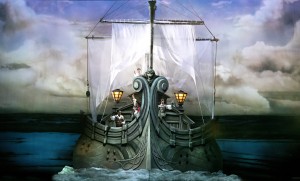 pasha has his harem dream, the corps is smartly dressed in creamy-colored tutus that together form a dreamy impressionistic stage picture.
pasha has his harem dream, the corps is smartly dressed in creamy-colored tutus that together form a dreamy impressionistic stage picture.
Note that the cast changes for each performance, but only true dance enthusiasts who see three or more showings will know the difference (and argue over who is better in which role). This fluffy fare is family-friendly, opulent and offers enough virtuoso performances (including ones from the corps) to hold the attention of even the most persnickety of spectators. Le Corsaire is hardly the best ballet around, but it is a perfect showcase for many astounding dancers. Considering the scope of the production – and the hundreds of people it takes to put it on – it’s mind-boggling that this recommended enterprise sails as smoothly as it does.
photos courtesy of ABT
American Ballet Theatre
Le Corsaire
presented by Glorya Kaufman Dance
The Music Center’s Dorothy Chandler Pavilion
scheduled to end on July 14, 2013
for tickets, visit http://www.musiccenter.org
